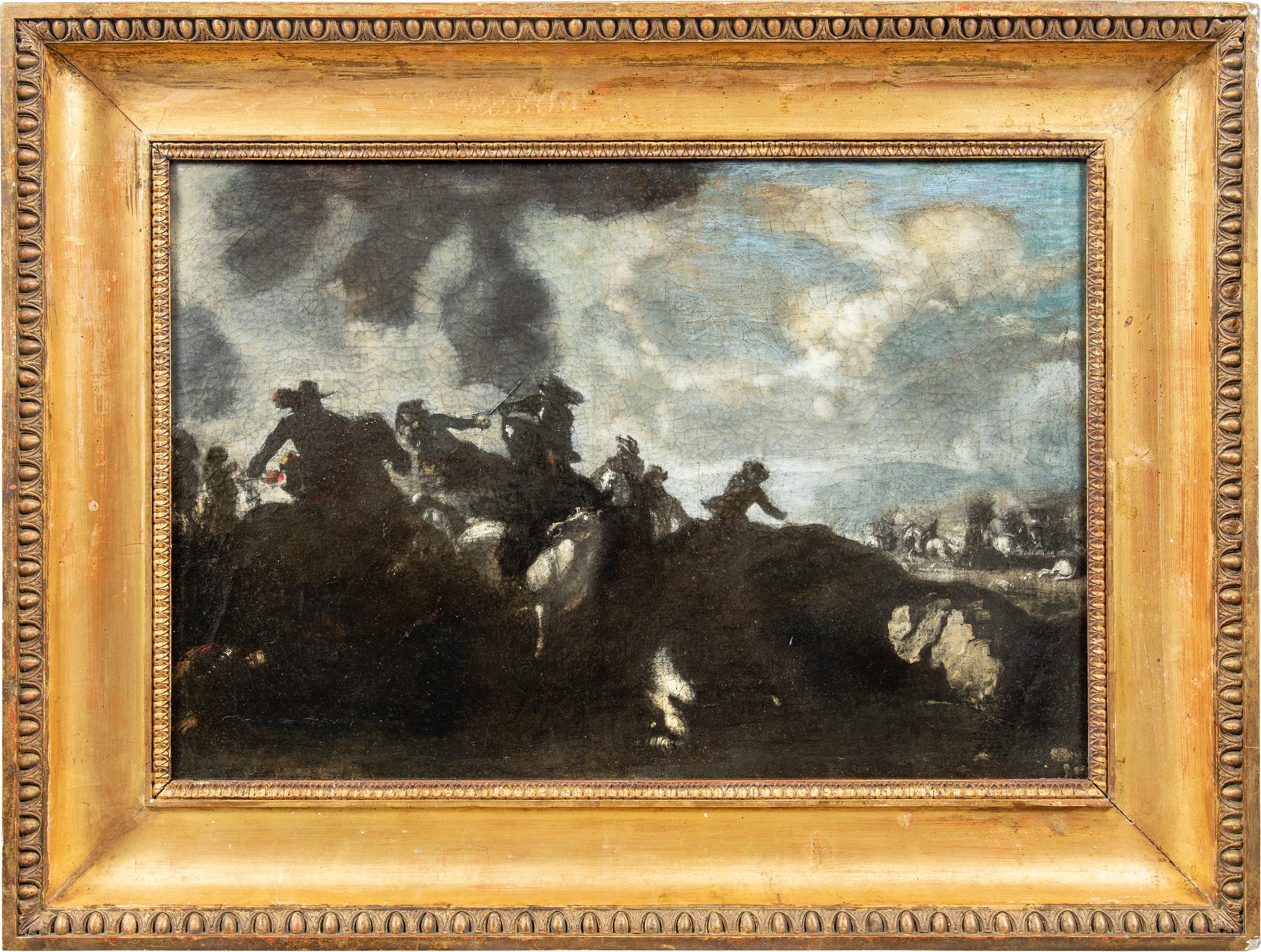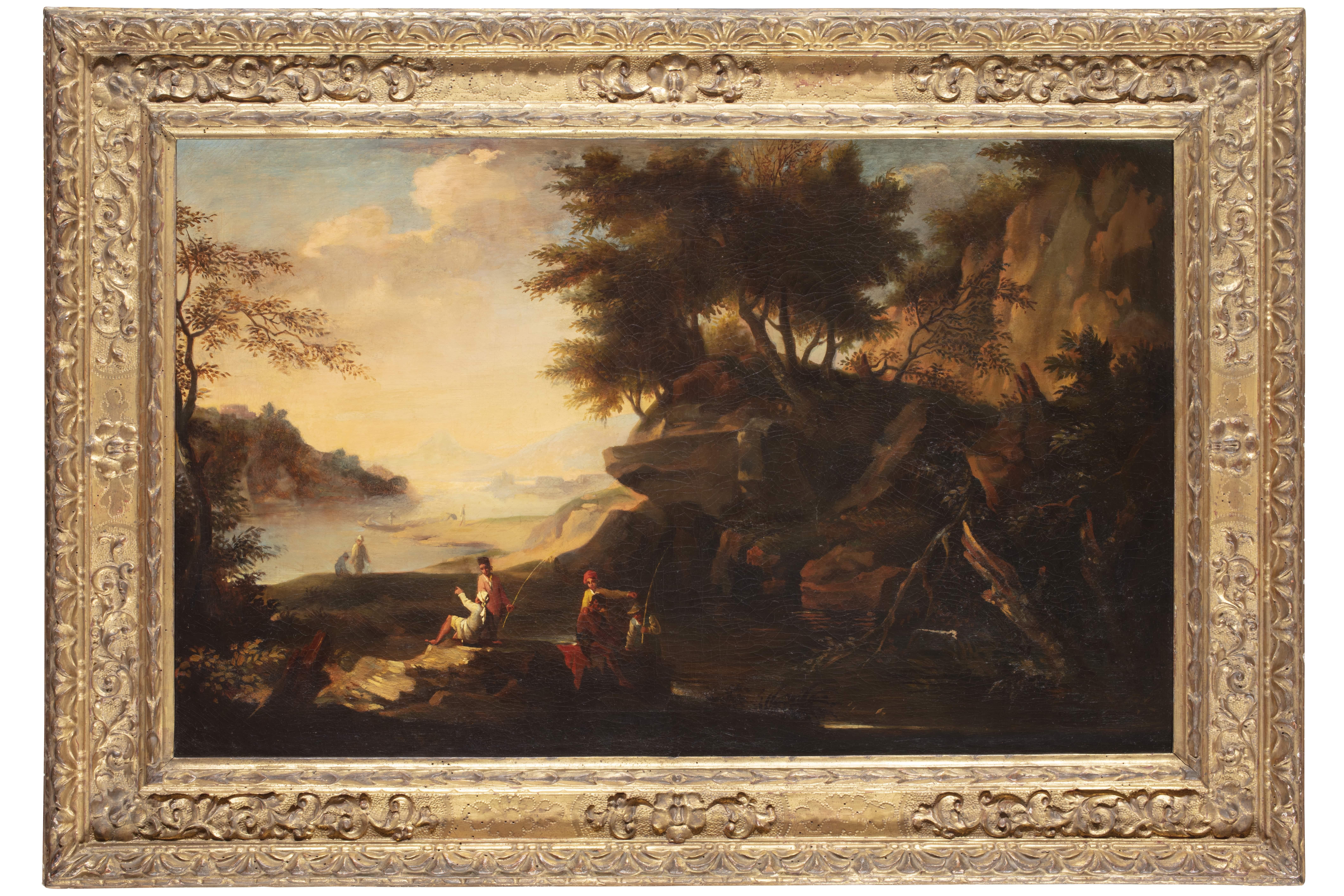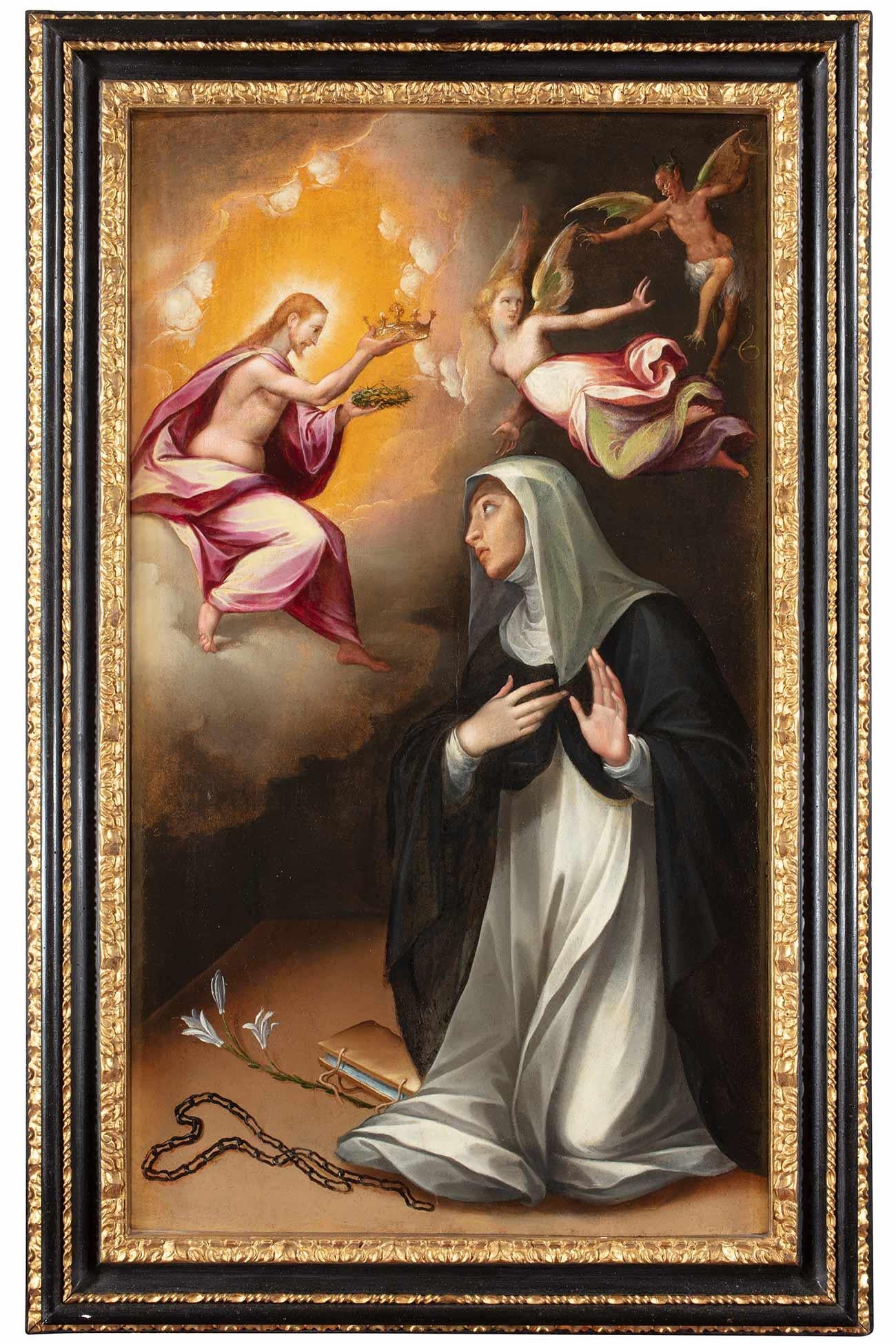Items Similar to Claude-Joseph Vernet 18th century Old Master landscape, grand tour Italy
Want more images or videos?
Request additional images or videos from the seller
1 of 12
Claude-Joseph VernetClaude-Joseph Vernet 18th century Old Master landscape, grand tour Italy
About the Item
Claude-Joseph Vernet (French, 1714 – 1789)
Fisherman by a cascade in a gorge
Oil on canvas
22.1/4 x 25.1/2 in. (56.5 x 64.7 cm.)
Provenance:
The estate of the late Betty, Lady Grantchester
Du Catalogue Collection #39
Christie's London, 3 Dec 1997, Lot 52 (£41,000)
Claude-Joseph Vernet was the leading French landscape painter (with Hubert Robert) of the later 18th century. He achieved great celebrity with his topographical paintings and serene landscapes. He was also one of the century's most accomplished painters of tempests and moonlight scenes.Vernet was born at Avignon and trained there with his father, Antoine, and with the history painter Philippe Sauvan. He spent the years 1734 to 1752 in Rome, where he studied classical landscapes in the tradition of Claude and Gaspard Dughet, as well as the dramatic paintings of Salvator Rosa. In Rome he was influenced by the contemporary Roman topographical painter Giovanni Paolo Panini. He had many English clients and admirers in Rome, including Richard Wilson, whom Vernet is thought to have encouraged as a landscape painter.Vernet became a member of the Academy on his return to France and in 1753 received the important royal commission for a series of large canvases representing the ports of France (1753-65).
- Creator:Claude-Joseph Vernet (1714 - 1789, French)
- Dimensions:Height: 22.25 in (56.52 cm)Width: 25.5 in (64.77 cm)Depth: 1 in (2.54 cm)
- Medium:
- Movement & Style:
- Period:
- Condition:Oil on canvas, relined. Paint surface in good order, recently cleaned and varnished (ask for photographs post restoration). In an expensive gilded frame.
- Gallery Location:Petworth, GB
- Reference Number:1stDibs: LU54038029892
About the Seller
4.9
Platinum Seller
These expertly vetted sellers are 1stDibs' most experienced sellers and are rated highest by our customers.
Established in 2010
1stDibs seller since 2017
228 sales on 1stDibs
Typical response time: 3 hours
- ShippingRetrieving quote...Ships From: Petworth, United Kingdom
- Return PolicyA return for this item may be initiated within 10 days of delivery.
More From This SellerView All
- Pair of early 20th Century British Impressionist paintings of the beachLocated in Petworth, West SussexAttributed to Rowland Wheelwright, 20th Century 'Bather's on the shore' and 'Sunbathing by the Cliffs' Oil on canvas board 9 X 10. 1/4in. (22.8 X 2...Category
20th Century Impressionist Figurative Paintings
MaterialsOil, Canvas, Board
- Naples during the Napoleonic occupation, oil on canvas painting, circa 1810Located in Petworth, West SussexNeapolitan school, circa 1810 Vessels on the key side at Naples during the Napoleonic occupation Oil on canvas 11.1/4 x 16.7/8 in. (28.1/2 x 43.2 cm.) It is unclear whether this wor...Category
19th Century Landscape Paintings
MaterialsOil, Canvas
- French 19th Century oil painting of The rescue of Deianara by Emile MenardLocated in Petworth, West SussexEmile Rene Menard (French, 1862-1930) L`enlevement de Dejanira (The rescue of Deianara) Oil on canvas Signed `E R Menard’ (lower left) and inscribed with t...Category
19th Century Academic Landscape Paintings
MaterialsCanvas, Oil
- British 20th Century oil painting of The palace at Fontainebleau, paris, FranceBy Walter TaylorLocated in Petworth, West SussexA striking and simply composed painting of The Palace at Fontainebleau by Walter Taylor. Walter Taylor (British, 1860-1943) The palace at Fontainebleau Oil on canvas Signed `Walter Taylor’ (lower right) 25 x 30 in. (63.5 x 76.3 cm.) Born in Leeds, this artist was trained as an architect but eventually found his calling in painting town scenes, landscapes, and interiors using both oil and watercolour. With a privileged upbringing thanks to his tobacco manufacturer father, he attended art school in Paris before studying under Fred Brown at the Royal College of Art. In 1899, he married Hylda Matheson, but their honeymoon ended in tragedy with her untimely death. He eventually settled in Bedford Square, Brighton, during the 1910s and 1920s, but maintained a studio at 18 Fitzroy Street in London from 1915 onwards. A prominent figure in the art world, he was a founder member and secretary of the Camden Town Group, a member of the New English Art Club, and one of the founding members of the London Group in 1913. He exhibited with the London Group until 1934, showcasing his work that often drew inspiration from his travels in Europe, which sometimes included the company of fellow artist Walter Sickert. Additionally, he painted extensively in London, Brighton, and Hove. This artist also had a keen eye for collecting works by other artists, amassing an important collection that included pieces by Matisse, Bonnard, Vuillard, Dufy, Gilman, Matthew Smith...Category
20th Century Post-Impressionist Landscape Paintings
MaterialsCanvas, Oil
- 20th Century British artist Leigh-Pemberton, painting of horses in landscapeLocated in Petworth, West SussexJohn Leigh-Pemberton (British, fl. 1933 – 1959) Timber horses, Tazmania Signed ‘John Leigh-Pemberton 1934’ (lower right) Oil on canvas 25 x 30 in. (63.5 x 76.2 cm.) Leigh-Pemberton is mainly known for his illustrations for the shell guides...Category
20th Century Modern Animal Paintings
MaterialsCanvas, Oil
- Contemporary 20th Century large blue abstract oil painting of Antipodean landBy Jenny FranklinLocated in Petworth, West SussexJenny Franklin (South African / British, b.1949) Antipodean land: Reflection Executed in 1993 Signed, inscribed and dated on the reverse Oil on canvas 48 x 42 in. (107 x 122 cm.) Ex...Category
Late 20th Century Abstract Landscape Paintings
MaterialsCanvas, Oil
You May Also Like
- A WolfLocated in New York, NYProvenance: The Marchesi Strozzi, Palazzo Strozzi, Florence Sale, Christie’s, London, May 20, 1993, lot 315, as by Carl Borromaus Andreas Ruthart...Category
17th Century Old Masters Animal Paintings
MaterialsPaper, Canvas, Oil
- 16th Century by Cristofano Roncalli Saint Catherine of Siena Oil on CanvasLocated in Milano, LombardiaCristofano Roncalli (Pomarance 1552 - Rome 1626) Saint Catherine of Siena chooses the crown of thorns oil on wood, cm. 101,5x59.5 - with frame cm. 120x76 Shaped, carved and sculpted wooden cassetta frame, partly gilded and partly ebonized wood Expertise: Marco Ciampolini The marvellous scene that opens before our eyes is that of Christ's apparition to Saint Catherine of Siena; she must choose between a golden crown, the symbol of earthly royalty, and a crown of thorns, the symbol of virtuous Christian sacrifice. Catherine does not hesitate to choose the crown of thorns, her life in imitation of...Category
16th Century Old Masters Landscape Paintings
MaterialsCanvas, Cotton Canvas, Oil
- Early oil depicting the Great Fire of LondonLocated in London, GBThe Great Fire of London in September 1666 was one of the greatest disasters in the city’s history. The City, with its wooden houses crowded together in narrow streets, was a natural fire risk, and predictions that London would burn down became a shocking reality. The fire began in a bakery in Pudding Lane, an area near the Thames teeming with warehouses and shops full of flammable materials, such as timber, oil, coal, pitch and turpentine. Inevitably the fire spread rapidly from this area into the City. Our painting depicts the impact of the fire on those who were caught in it and creates a very dramatic impression of what the fire was like. Closer inspection reveals a scene of chaos and panic with people running out of the gates. It shows Cripplegate in the north of the City, with St Giles without Cripplegate to its left, in flames (on the site of the present day Barbican). The painting probably represents the fire on the night of Tuesday 4 September, when four-fifths of the City was burning at once, including St Paul's Cathedral. Old St Paul’s can be seen to the right of the canvas, the medieval church with its thick stone walls, was considered a place of safety, but the building was covered in wooden scaffolding as it was in the midst of being restored by the then little known architect, Christopher Wren and caught fire. Our painting seems to depict a specific moment on the Tuesday night when the lead on St Paul’s caught fire and, as the diarist John Evelyn described: ‘the stones of Paul’s flew like grenades, the melting lead running down the streets in a stream and the very pavements glowing with the firey redness, so as no horse, nor man, was able to tread on them.’ Although the loss of life was minimal, some accounts record only sixteen perished, the magnitude of the property loss was shocking – some four hundred and thirty acres, about eighty per cent of the City proper was destroyed, including over thirteen thousand houses, eighty-nine churches, and fifty-two Guild Halls. Thousands were homeless and financially ruined. The Great Fire, and the subsequent fire of 1676, which destroyed over six hundred houses south of the Thames, changed the appearance of London forever. The one constructive outcome of the Great Fire was that the plague, which had devastated the population of London since 1665, diminished greatly, due to the mass death of the plague-carrying rats in the blaze. The fire was widely reported in eyewitness accounts, newspapers, letters and diaries. Samuel Pepys recorded climbing the steeple of Barking Church from which he viewed the destroyed City: ‘the saddest sight of desolation that I ever saw.’ There was an official enquiry into the causes of the fire, petitions to the King and Lord Mayor to rebuild, new legislation and building Acts. Naturally, the fire became a dramatic and extremely popular subject for painters and engravers. A group of works relatively closely related to the present picture have been traditionally ascribed to Jan Griffier...Category
17th Century Old Masters Landscape Paintings
MaterialsCanvas, Oil
- View of Ponte Milvio in RomeLocated in Roma, RMNorthern painter active in Rome in the second half of the 17th century, View of Ponte Milvio Oil painting on canvas 73 x 97 cm in coeval Roman Salvator Rosa frame.Category
18th Century and Earlier Old Masters Landscape Paintings
MaterialsCanvas, Oil
- 17th Century by Felice Torelli Rachel Hiding the Idols Oil on CanvasLocated in Milano, LombardiaFelice Torelli (Verona 1667 - Bologna 1748) Rachel Hiding the Idols Oil on canvas, 41 x 116 cm without frame - 52,5 x 127 cm with frame Original shape...Category
Late 17th Century Old Masters Landscape Paintings
MaterialsCanvas, Cotton Canvas, Oil
- 19th Century By Giustino Menescardi Ascent to Calvary Oil on CanvasLocated in Milano, LombardiaGiustino Menescardi (Milan, c. 1720 - Venice, after 1779) Ascent of Calvary Oil on canvas, cm. 47 x 36 - with frame cm. 57x43 Shaped and gilded wooden cassetta frame Publications: Bozzetti, modelletti, sketches: dalla collezione di Giorgio Baratti...Category
Early 18th Century Old Masters Landscape Paintings
MaterialsCotton Canvas, Canvas, Oil
Recently Viewed
View AllMore Ways To Browse
Old Wellers Antique
Old Weller Antique
18th Century Oil
Large Old Master
Masters Of 18th Century
18th Century Old Masters
French Painting 18th
18th Century French Paintings
Large 18th Century Painting
English Old Master
18th French Oil
French 18th Century Oil
18th Century English Painting
18th Century French Masters
Old English 18th Century
18th French Oil Painting
Old Masters Rome
18th Century Oil Paintings Large




